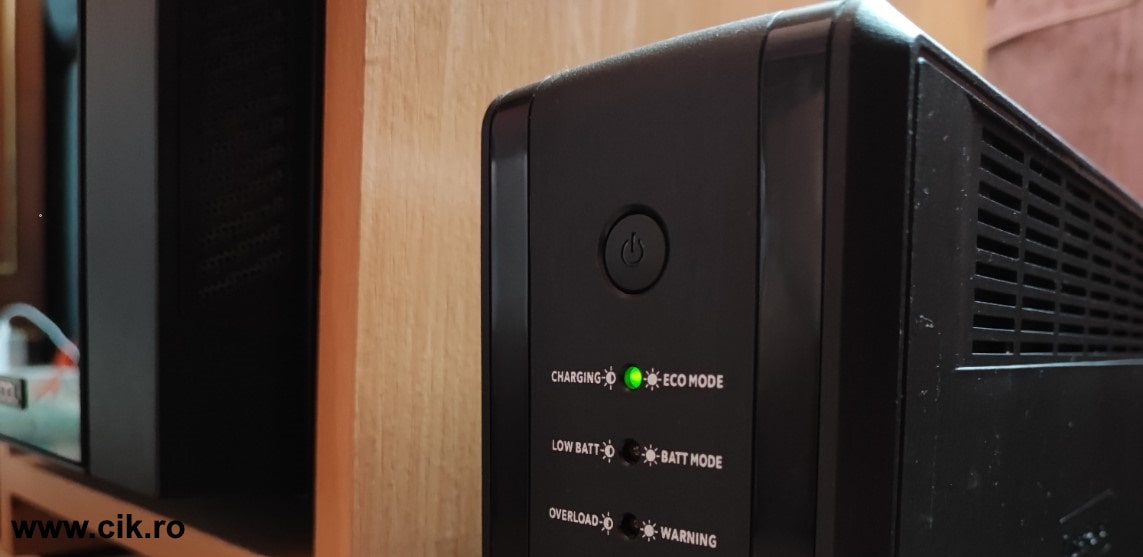In This Article, I Will Write About My CyberPower UPS, Which I Chose Because It Has Gigabit LAN Protection on RJ-45 for Both Network and Lightning Surges, Without Slowing Down My Gigabit Internet Connection.
Uninterruptible power supplies, or UPSs, come in three types: offline UPSs, which do nothing except analyze if your electrical system is functional and automatically switch to battery power in case of a power outage; line-interactive UPSs, which analyze the electric voltage and, if it exceeds or drops below certain limits, try to stabilize it using relays, and if they fail, they also switch to battery power using the AC/DC inverter they have; online UPSs, the best and most capable of all, but also the most expensive, which are also known as double-conversion UPSs.
They are the most capable uninterruptible power supplies because what comes from your power outlet has no connection to what comes out, as the output is completely controlled and stabilized by the UPS, with a very small margin of error (around +-2%) compared to line-interactive UPSs, where the relays have a margin of error somewhere around 8-10%. Also, the output waveform of online UPSs is pure sine wave, which increases the lifespan of electrical equipment. Between online UPSs and line-interactive UPSs, there are also servo motor-based voltage stabilizers, which also have a voltage margin that they stabilize (around 3-5%) and provide a pure sine wave output. The disadvantage of servo motor-based voltage stabilizers is that they are noisy and require maintenance, otherwise they can break.
Today I will write about my line-interactive UPS from CyberPower, which is made by an American company in Taiwan. I chose a CyberPower UPS because I was looking for an uninterruptible power supply that has surge protection for both network and lightning on the RJ-45 port, with a pass-through of one gigabit per second, without slowing down a gigabit internet connection.
I was looking for such a UPS after a lightning strike on the apartment building where I live burned the WAN port of my gigabit Tenda router. I was very satisfied with that Tenda router, which has a decent price for what it can do, and I felt sorry when it got damaged because of that lightning. In the end, I chose the CyberPower UT1050EG line-interactive UPS, which can handle a maximum of 630W before going into protection mode, to protect my PC, monitor, audio system (Logitech Z-5500), and the new router (TP-LINK Archer C2300).
The 630 watts are sufficient if we consider that the computer consumes the most power, up to 400W, when I use it to its maximum while playing PUBG. Yes, PUBG for computers is the application that consumes the most power among all the games I’ve tried, from CS Global Offensive to Call of Duty Modern Warfare.
The CyberPower UT1050EG cost around 100 US dollars, and I chose it because it has four Shuko outlets on the back and gigabit surge protection on the LAN (RJ-45). The fact that the network cable passes through it and the internet speed is almost exactly the same and is not reduced is a big plus.
Pay great attention because not all UPSs have protection on RJ-45: some don’t have it at all, others only have it on RJ-12, which is for fax and won’t work if you use that port with an RJ-45 connection, while others have protection on LAN RJ-45. By the way, does anyone still use fax machines nowadays, apart from public institutions?
At the moment when that lightning struck the building and burned the WAN port of my gigabit Tenda router, my internet provider was a neighborhood company that used cheap equipment without protection against such incidents. The subscription at that time was for 100Mbps upload/download. In the meantime, I moved to another ISP that uses professional network equipment (routers, switches, etc.) on a gigabit internet subscription (around 930Mbps download and 450Mbps upload), so the risk of any unfortunate event happening again is low, but not excluded so I continue to use the UPS protection on RJ-45.
The UPS is located next to the desk where I keep my desktop computer, and from there, a 15-meter (49 ft) FTP cable starts, which goes to the WAN port of my TP-LINK router, located in the middle of the apartment, near the ceiling, to cover all four rooms that have thick concrete walls. It is well known that radio waves propagate downwards, so it is good to place our router as high as possible in the center of the living space to have a good signal and speed throughout.
The CyberPower UT1050EG, being a UPS without a display, consumes very little electrical energy, somewhere below one watt, as all it does is monitor the voltage from the power outlet without modifying it.
It only intervenes when there are major fluctuations. A UPS with a display consumes somewhere between 2-5 watts, depending on the screen size, so if you want to be environmentally friendly and not waste our planet’s resources, buy a UPS without a display.
As an experiment, I wanted to see how stable my main power supply is: how many times the power goes out in a year and how many times there are overvoltage or undervoltage issues on the network.
So, I bought a mini laptop from a pawn shop, which doesn’t consume much power, for around 50 dollars, and connected it to my CyberPower UPS using a USB A to Type B cable, which I had to buy separately since it’s not included among the things that come with the UPS.
Speaking of software, CyberPower has a very good and stable monitoring and management program that allows you to disable the UPS alarm when the power goes out and switches to battery mode.
Some UPSs don’t have this option, and you have to open them up and disconnect the speaker wire to avoid being disturbed by the loud sound they make when the main power supply goes out. Moreover, the CyberPower software has the option to configure an email account with Gmail, for example, to receive notifications in case of any events related to your power supply.
This is a cheap way to monitor the UPS because enterprise UPSs with monitoring ports are expensive, and you have to purchase/renew various licenses. I monitored the UPS for about a year, during which there were no overvoltage or undervoltage issues on the power grid, and the power went out for very short periods, like a minute or two, only three times in 365 days. Obviously, if there is overvoltage or undervoltage, the UPS can immediately send you an email. However, if the power goes out, even if your router is working, it cannot send you an email until the main power supply is restored because you won’t have an internet connection, unless you use, let’s say, a backup 4G network on the router’s USB port.
In the future, I want to buy an online UPS with double conversion or at least a voltage stabilizer with a servomotor because, as I mentioned above, pure sine wave extends the lifespan of electrical equipment, and stable voltage is also helpful when it comes to sensitive equipment such as computers, routers, or audio devices that require good quality power without noise.
I hope that my advice will be useful to you if you want to buy a UPS with LAN RJ-45 protection that doesn’t decrease your gigabit internet connection because many people don’t even know such a thing exists. Even the technicians from the new ISP who came to install my gigabit connection didn’t know about such equipment, and they work in the field.
As a conclusion, I want to ask you a few things: has any of your electronic equipment ever been damaged due to overvoltage, power outages, or lightning strikes? You can answer in the comments section below.




